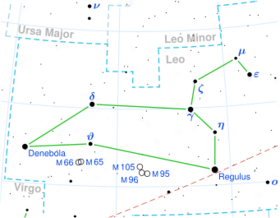72 Leonis
Topic: Astronomy
 From HandWiki - Reading time: 3 min
From HandWiki - Reading time: 3 min
| Observation data Equinox J2000.0]] (ICRS) | |
|---|---|
| Constellation | Leo |
| Right ascension | 11h 15m 12.22709s[1] |
| Declination | +23° 05′ 43.8373″[1] |
| Apparent magnitude (V) | 4.63[2] |
| Characteristics | |
| Spectral type | M3 IIb[3] |
| B−V color index | 1.657±0.003[4] |
| Variable type | LC[5] |
| Astrometry | |
| Radial velocity (Rv) | 14.76±0.21[4] km/s |
| Proper motion (μ) | RA: −25.56[1] mas/yr Dec.: −6.00[1] mas/yr |
| Parallax (π) | 3.40 ± 0.65[1] mas |
| Distance | approx. 1,000 ly (approx. 290 pc) |
| Absolute magnitude (MV) | −2.69[4] |
| Details | |
| Mass | 3.11[6] M☉ |
| Radius | 195[6] R☉ |
| Luminosity | 5,770[7] L☉ |
| Surface gravity (log g) | 1.16[6] cgs |
| Temperature | 3,613±48[6] K |
| Metallicity [Fe/H] | −0.03[6] dex |
| Age | 400[6] Myr |
| Other designations | |
| Database references | |
| SIMBAD | data |
72 Leonis is a single[9] variable star in the zodiac constellation of Leo, located roughly 1,000 light years away from the Sun.[1] It has the variable star designation FN Leonis; 72 Leonis is the Flamsteed designation. In Chinese astronomy, 72 Leonis is called 虎賁, Pinyin: Hǔbēn, meaning Emperor’s Bodyguard, because this star is marking itself and stands alone in the Emperor’s Bodyguard asterism, Supreme Palace enclosure mansion (see : Chinese constellation).[10]
This object is visible to the naked eye as a red-hued star with an apparent visual magnitude of 4.56.[4] It is an evolved bright giant with a stellar classification of M3 IIb and was listed as a spectral standard star for that class.[3] The star is classified as an irregular variable of type LC, ranging from Hipparcos magnitude 4.56 down to 4.64.[5] It has a radius 162 to 179[11] times that of the Sun and radiates 5,407[12] times the Sun's luminosity at an effective temperature of around 3,734 K.[13] The star is moving away from the Earth with a heliocentric radial velocity of 15 km/s.[4]
References
- ↑ 1.0 1.1 1.2 1.3 1.4 1.5 van Leeuwen, F. (2007), "Validation of the new Hipparcos reduction", Astronomy and Astrophysics 474 (2): 653–664, doi:10.1051/0004-6361:20078357, Bibcode: 2007A&A...474..653V.
- ↑ Ducati, J. R. (2002), "VizieR Online Data Catalog: Catalogue of Stellar Photometry in Johnson's 11-color system", CDS/ADC Collection of Electronic Catalogues 2237, Bibcode: 2002yCat.2237....0D.
- ↑ 3.0 3.1 Keenan, Philip C.; McNeil, Raymond C. (1989), "The Perkins catalog of revised MK types for the cooler stars", Astrophysical Journal Supplement Series 71: 245, doi:10.1086/191373, Bibcode: 1989ApJS...71..245K.
- ↑ 4.0 4.1 4.2 4.3 4.4 Anderson, E.; Francis, Ch. (2012), "XHIP: An extended hipparcos compilation", Astronomy Letters 38 (5): 331, doi:10.1134/S1063773712050015, Bibcode: 2012AstL...38..331A.
- ↑ 5.0 5.1 Samus, N. N. et al. (2017), "General Catalogue of Variable Stars", Astronomy Reports, 5.1 61 (1): 80–88, doi:10.1134/S1063772917010085, Bibcode: 2017ARep...61...80S.
- ↑ 6.0 6.1 6.2 6.3 6.4 6.5 Baines, Ellyn K.; Armstrong, J. Thomas; Schmitt, Henrique R.; Zavala, R. T.; Benson, James A.; Hutter, Donald J.; Tycner, Christopher; Van Belle, Gerard T. (2018), "Fundamental Parameters of 87 Stars from the Navy Precision Optical Interferometer", The Astronomical Journal 155 (1): 30, doi:10.3847/1538-3881/aa9d8b, Bibcode: 2018AJ....155...30B.
- ↑ McDonald, I.; Zijlstra, A. A.; Watson, R. A. (2017), "Fundamental parameters and infrared excesses of Tycho-Gaia stars", Monthly Notices of the Royal Astronomical Society 471 (1): 770, doi:10.1093/mnras/stx1433, Bibcode: 2017MNRAS.471..770M.
- ↑ "72 Leo". SIMBAD. Centre de données astronomiques de Strasbourg. http://simbad.u-strasbg.fr/simbad/sim-basic?Ident=72+Leo.
- ↑ Eggleton, P. P.; Tokovinin, A. A. (September 2008), "A catalogue of multiplicity among bright stellar systems", Monthly Notices of the Royal Astronomical Society 389 (2): 869–879, doi:10.1111/j.1365-2966.2008.13596.x, Bibcode: 2008MNRAS.389..869E.
- ↑ Leo the Lion, Ian Ridpath's Startales, http://www.ianridpath.com/startales/leo.htm, retrieved 2019-02-10.
- ↑ Kaler, James B. (May 11, 2012), 72 Leonis, http://stars.astro.illinois.edu/sow/72leo.html, retrieved 2017-10-09.
- ↑ McDonald, I. et al. (2012), "Fundamental parameters and infrared excesses of Hipparcos stars", Monthly Notices of the Royal Astronomical Society 427 (1): 343–357, doi:10.1111/j.1365-2966.2012.21873.x, Bibcode: 2012MNRAS.427..343M.
- ↑ Dyck, H. M. et al. (1998), "Radii and Effective Temperatures for K and M Giants and Supergiants. II", The Astronomical Journal 116 (2): 981, doi:10.1086/300453, Bibcode: 1998AJ....116..981D.
- ↑ "Hipparcos Tools Interactive Data Access". ESA. https://www.cosmos.esa.int/web/hipparcos/interactive-data-access.
 |
 KSF
KSF


